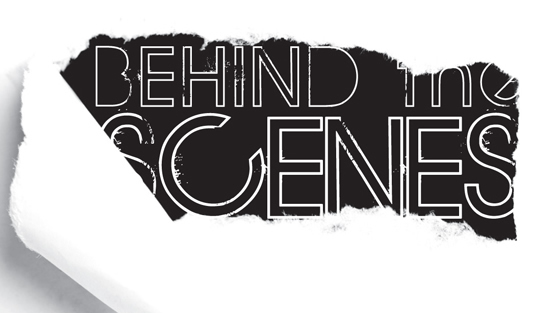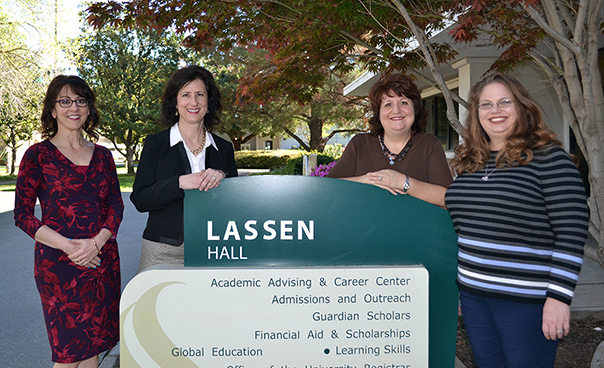BEHIND THE SCENES

Behind the Scenes - Student Financial Services Supports the President's Graduation Initiatives
In this edition of Behind the Scenes, we take a look at President Nelsen's renewed focus on the graduation rates and the graduation initiative at Sacramento State.
President Nelsen emphasized the amount of work that is needed to progress: "We have important work to do as we increase freshman and transfer graduation rates, decrease the time to degree, provide the classes that our students need, and close the achievement gaps."
Currently, the obstacles appear difficult to overcome. Only eight percent of Sacramento State's incoming freshman graduate in four years. Additional pressure has come from the CSU, who have set a goal of 24 percent by May of 2025.
The Student Financial Services Center (SFSC) is a key player in the initiative. With goals planned in enhanced communication, data collection and advisories, progress meters and the new One-Stop student center, the SFSC is taking their role seriously.
"When a new president arrived, we knew changes were expected, including the appointment of a graduation czar," said Curry. With the daunting task at hand, many committees and groups are working to try to  meet the president's call. (Interim) Associate Vice President of Financial Services Gina Curry is a part of the Graduation Initiative Business Process Team (GIBP), composed of members from across multiple offices. In addition to Gina Curry, Elena Larson and Nicole Rogers join the committee, along with former ABA employee, Julie Carrol.
meet the president's call. (Interim) Associate Vice President of Financial Services Gina Curry is a part of the Graduation Initiative Business Process Team (GIBP), composed of members from across multiple offices. In addition to Gina Curry, Elena Larson and Nicole Rogers join the committee, along with former ABA employee, Julie Carrol.
The first order of business for the team is communication. "Communication is the key to get students to see be aware of their requirements, and determine if they need advising. Students were ignoring messages through email," said Curry. As a result, the team has begun looking at new and alternative ways to reach students to communicate important deadlines, advising requirements, and other roadblocks that slow graduation. One proposed idea is via text message. Using a system similar to the Emergency Notification System (ENS), students could receive text messages alerting them if they are falling behind on financial or academic requirements.
The new One-Stop Center, targeted for full implementation in fall 2016, is another big enterprise that is hoped to support graduation. At the One-Stop Center, students can get basic questions answered on a multitude of issues ranging from tuition payment options, financial aid and admissions information to advising. Each employee at the One-Stop Center will be trained to gain the experience to help one another. The goal is for employees to be able to help each other, and work together to serve more students.
Communication is important to the graduation initiative, but it isn't all that the team is considering. A new tool being developed is the SmartPlanner Tool. This tool would be incorporated into a student's MySacState Student Center, and would allow a student to "plan" their graduation path, with requirements built in. The significance of this tool is that it creates a feedback loop. When students begin filling in their planned classes, years ahead, the University will be able to take that data and compare it to the number of classes offered in a given subject. This will help reduce waitlists and other potential bottlenecks by offering more classes to meet expected demand, before classes fill up.
Data has been an important part of the Graduation Initiative Business Process Team, and it allows them to look at the potential causes of delayed graduation, and retention issues. For many students, they are finding they aren't progressing far enough toward a degree to keep receiving financial aid. Of the 2,363 students who had their  enrollment cancelled in fall 2015, 1,545 re-enrolled, while 818 did not. Significantly, of that 818, 723 were financial aid applicants. And of those 723 financial aid applicants, only 74 had aid offered or accepted. Students are simply not graduating in time, and are dropping out when financial aid is no longer available, which is why progressing towards a degree is so important.
enrollment cancelled in fall 2015, 1,545 re-enrolled, while 818 did not. Significantly, of that 818, 723 were financial aid applicants. And of those 723 financial aid applicants, only 74 had aid offered or accepted. Students are simply not graduating in time, and are dropping out when financial aid is no longer available, which is why progressing towards a degree is so important.
Appropriately named, the Progress to Degree (P2D) project is another tool available to students. In its current form, it displays important requirements in a student's progress towards completing their degree, including unit requirements, undergraduate requirements, and deadlines for applying for graduation. The P2D includes a "progress meter" that gives points as a student progresses through their completed items, while also listing any incomplete items needed before graduation.
The P2D tool also helps remind students of the progress needed in order to keep receiving financial aid, and alerts them to reach out to advising if they are falling behind. Seventy-five percent of students receive financial aid or loans to help pay for tuition and other expenses, so staying on track is essential.
Between P2D, the Smart Planner Tool, the One-Stop Center, and new communication methods, the GIBP Team is working hard to meet the challenge set forth by the president. "It gets me fired up," explains Curry. "When you can help a student, it can be so rewarding. Helping them is exciting, and it should be the goal for each of us."



